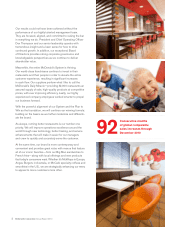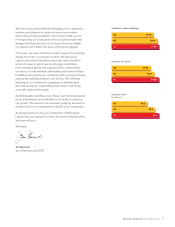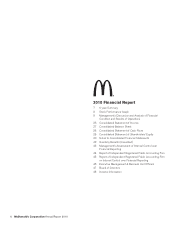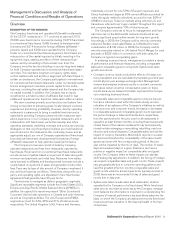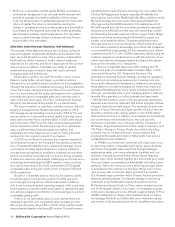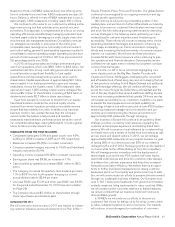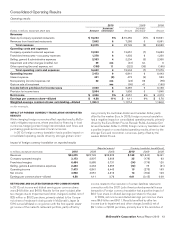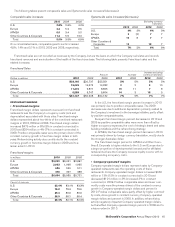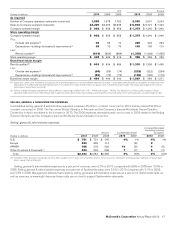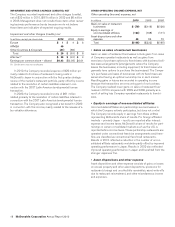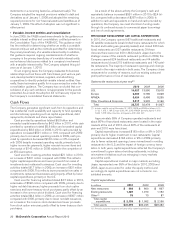McDonalds 2010 Annual Report Download - page 14
Download and view the complete annual report
Please find page 14 of the 2010 McDonalds annual report below. You can navigate through the pages in the report by either clicking on the pages listed below, or by using the keyword search tool below to find specific information within the annual report.items, food events and limited-time offerings to present a bal-
anced mix of products to our customers. Value will continue to be
a key growth driver as we reinforce the affordability of our menu
to consumers and build on our successful Value Lunch platforms.
We will invest in our business primarily by opening over 600 new
restaurants and reimaging over 500 existing restaurants while
elevating our focus on service and operations to drive efficien-
cies. In China, we will continue to build a foundation for long-term
growth by increasing our base of restaurants by approximately
15% in 2011 toward our goal of nearly 2,000 restaurants by the
end of 2013. Convenience initiatives include expanding delivery
service across the region and building on the success of our
extended operating hours.
McDonald’s has an ongoing commitment to optimize our res-
taurant ownership structure. A heavily franchised, less capital-
intensive business model has favorable implications for the
strength and stability of our cash flow, the amount of capital we
invest and long-term returns.
We continue to maintain a strong culture of financial dis-
cipline by effectively managing all spending in order to maximize
business performance. In making capital allocation decisions, our
goal is to elevate the McDonald’s experience by driving sustain-
able growth in sales and market share while earning strong
returns. We remain committed to returning all of our free cash
flow (cash from operations less capital expenditures) to share-
holders over the long term via dividends and share repurchases.
McDonald’s does not provide specific guidance on diluted
earnings per share. The following information is provided to assist
in analyzing the Company’s results:
• Changes in Systemwide sales are driven by comparable sales
and net restaurant unit expansion. The Company expects net
restaurant additions to add approximately 1.5 percentage
points to 2011 Systemwide sales growth (in constant
currencies), most of which will be due to the 541 net traditional
restaurants added in 2010.
• The Company does not generally provide specific guidance on
changes in comparable sales. However, as a perspective,
assuming no change in cost structure, a 1 percentage point
increase in comparable sales for either the U.S. or Europe
would increase annual diluted earnings per share by about
3 cents.
• With about 75% of McDonald’s grocery bill comprised of 10
different commodities, a basket of goods approach is the most
comprehensive way to look at the Company’s commodity costs.
For the full year 2011, the total basket of goods cost is
expected to increase 2-2.5% in the U.S. and to increase
3.5-4.5% in Europe as compared to 2010. Some volatility may
be experienced between quarters in the normal course of
business.
• The Company expects full-year 2011 selling, general & admin-
istrative expenses to decrease 2-3%, in constant currencies,
partly due to higher incentive compensation in 2010 based on
performance. In addition, fluctuations will be experienced
between quarters due to certain items in 2010, such as the
Vancouver Winter Olympics in February and the biennial
Worldwide Owner/Operator Convention in April.
• Based on current interest and foreign currency exchange rates,
the Company expects interest expense for the full year 2011
to increase approximately 7% compared with 2010.
• A significant part of the Company’s operating income is gen-
erated outside the U.S., and about 40% of its total debt is
denominated in foreign currencies. Accordingly, earnings are
affected by changes in foreign currency exchange rates,
particularly the Euro, Australian Dollar, British Pound and
Canadian Dollar. Collectively, these currencies represent
approximately 65% of the Company’s operating income out-
side the U.S. If all four of these currencies moved by 10% in
the same direction, the Company’s annual diluted earnings per
share would change by about 20 cents.
• The Company expects the effective income tax rate for the full
year 2011 to be approximately 30% to 32%. Some volatility
may be experienced between the quarters resulting in a quar-
terly tax rate that is outside the annual range.
• The Company expects capital expenditures for 2011 to be
approximately $2.5 billion. About half of this amount will be
used to open new restaurants. The Company expects to open
about 1,100 restaurants including about 400 restaurants in
affiliated and developmental licensee markets, such as Japan
and Latin America, where the Company does not fund any
capital expenditures. The Company expects net additions of
about 750 traditional restaurants. The remaining capital will be
used for reinvestment in existing restaurants. Over half of this
reinvestment will be used to reimage approximately 2,200
locations worldwide, some of which will require no capital
investment from the Company.
12 McDonald’s Corporation Annual Report 2010


